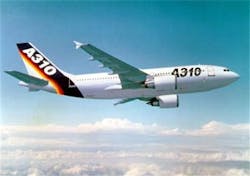WASHINGTON (AP) -- U.S. airlines will be ordered to inspect the rudders of certain Airbus jets following an incident in which most of the rudder fell off an A310 in flight, a spokesman for the Federal Aviation Administration said Friday.
The FAA directive, to be issued Monday, affects A310s and A300-600s. American Airlines and FedEx, the only U.S. airlines that fly those models, have a combined 112 of those planes.
A plane operated by Canadian-based Air Transat lost nearly all of the rudder - the vertical moving part at the back of the tail fin - soon after leaving Cuba for Quebec on March 6. The pilot was able to control the aircraft and returned to Varadero, Cuba. None of the 270 passengers and crew was injured.
''No one knows for sure what really happened, but we feel this is a prudent measure,'' FAA spokesman Les Dorr said of the order. ''The basic idea is to get somebody up looking at the rudder to see if there are any problems that can be detected visually or with the tap test.''
A tap test is a way to inspect parts by tapping a piece of metal or a coin against the surface while listening for dull spots. Bill Waldock, an aviation safety professor at Embry-Riddle Aeronautical University in Arizona, said it's an extremely time-consuming process. ''You got a mechanic out there who's going to spend a lot of time tapping.''
The FAA directive follows a similar order by French civil aviation authorities on March 18. European aircraft maker Airbus SAS also asked airlines to inspect the planes last week out of what it called ''an abundance of caution.''
Airbus spokeswoman MaryAnne Greczyn said the Airbus request speeds up the regular five-year inspection cycle.
The Air Transat incident has prompted discussion about the aging characteristics of composites, a relatively new building material which the A300 rudders are made of. Composites are man-made materials made of at least two different kinds of substances; the Airbus rudders are made of carbon fiber and reinforced epoxy.
Composites have been used in aircraft manufacture since the 1970s, first as smaller components and then as larger parts. Airbus was the first manufacturer to use composites extensively on large commercial aircraft. Boeing also uses them.
An Airbus A300-600, which has the same rudder system as the A310, crashed in New York in November 2001 after its tail fell off and killed 265 people. The National Transportation Safety Board blamed pilot error, inadequate pilot training and overly sensitive rudder controls.
Investigators conducted extensive tests on the tail and found no evidence of fatigue, which occurs in aging components and can cause cracking.
Dorr said U.S. airlines have to inspect the plans within 550 flight hours or three months.
French civil aviation authorities also told airlines to inspect A330s and A340s because the rudders are the same or similar to the A300-600 and A310. The FAA didn't order A330s to be inspected because the planes used in the United States have different rudders. There are no A340s registered in the United States.





